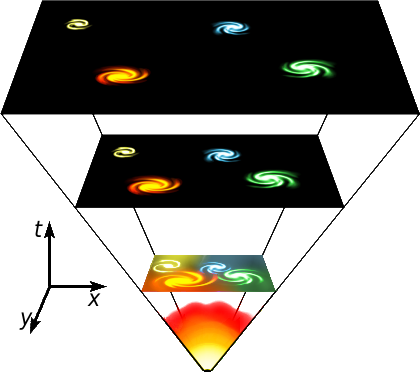How does the Big Bang theory explain the evolution of the universe?
“Discover how the Big Bang Theory explains the evolution of the universe, from the initial singularity to cosmic inflation, and the formation of galaxies. Explore key concepts like dark matter, dark energy, nucleosynthesis, and the role of the cosmic microwave background in understanding our expanding universe.”
IF YOU WANT TO DOWNLOAD POWER POINT FILE OF THIS PRESENTATION SCROLL DOWN AND CLICK ON THE DOWNLOAD BUTTON
The Big Bang Theory is one of the most profound scientific explanations for the origin and evolution of the universe. This theory not only describes how the universe began but also how it has evolved over billions of years to its current state. In this blog post, we’ll explore the key concepts and evidence supporting the Big Bang Theory, making complex ideas accessible and engaging for students, enthusiasts, and anyone curious about our cosmic origins.
Historical Context
The Big Bang Theory was first proposed by Georges Lemaître in the 1920s, who suggested that the universe expanded from an initial singularity. This idea was later supported by Edwin Hubble’s observations in the 1920s, which showed that galaxies are moving away from us, indicating that the universe is expanding.

The Initial Singularity and Cosmic Inflation
The Big Bang Theory posits that the universe began as an incredibly hot and dense singularity approximately 13.8 billion years ago. During the first fraction of a second, the universe underwent a rapid expansion known as cosmic inflation. This inflationary period stretched the universe exponentially, smoothing out any initial irregularities and setting the stage for the large-scale structure we observe today.
Expansion of the Universe
As the universe expanded, it cooled, allowing particles to form. This cooling process led to the creation of protons, neutrons, and electrons, which eventually combined to form hydrogen and helium atoms. The expansion of the universe is described by Hubble’s Law, which states that the farther away a galaxy is, the faster it is moving away from us. This observation provides strong evidence for an expanding universe.
Cosmic Microwave Background (CMB)
One of the most compelling pieces of evidence for the Big Bang Theory is the cosmic microwave background (CMB) radiation. Discovered in 1965 by Arno Penzias and Robert Wilson, the CMB is the afterglow of the Big Bang, a faint microwave radiation that fills the universe. It provides a snapshot of the universe when it was just 380,000 years old, offering insights into its early conditions and confirming predictions of the Big Bang Theory.

Formation of Galaxies and Large-Scale Structure
As the universe continued to expand and cool, matter began to clump together under the influence of gravity, forming the first stars and galaxies. These structures eventually evolved into the complex web of galaxies, clusters, and superclusters we see today. The study of galaxy formation and large-scale structure helps us understand the processes that shaped the universe.
Nucleosynthesis and the Formation of Elements
During the first few minutes after the Big Bang, nuclear reactions occurred, leading to the formation of light elements such as hydrogen, helium, and trace amounts of lithium. This process, known as Big Bang nucleosynthesis, produced the primordial elements that served as the building blocks for later stellar nucleosynthesis in stars.
Dark Matter and Dark Energy
While the Big Bang Theory explains much about the universe’s evolution, it also raises questions about the nature of dark matter and dark energy. Dark matter is thought to make up about 27% of the universe’s mass-energy content, influencing the formation and behavior of galaxies. Dark energy, accounting for roughly 68% of the universe, is believed to drive the accelerated expansion of the universe. Understanding these mysterious components remains one of the biggest challenges in modern cosmology.
Key Observations and Evidence
- Redshift: The redshift of light from distant galaxies indicates that the universe is expanding.
- Hubble Space Telescope: Observations from the Hubble Space Telescope have provided detailed images and data on the universe’s expansion and structure.
- Gravitational Waves: The detection of gravitational waves has opened a new window into studying cosmic events and the early universe.
- Quantum Fluctuations: Tiny quantum fluctuations during cosmic inflation are believed to have seeded the formation of galaxies.
Alternative Theories and Models
While the Big Bang Theory is widely accepted, alternative models such as the steady state theory and various cyclic models have been proposed. These models offer different explanations for the universe’s origins and evolution but lack the comprehensive evidence supporting the Big Bang Theory.
The Fate of the Universe
The Big Bang Theory also prompts questions about the universe’s ultimate fate. Will it continue to expand indefinitely, or will it eventually collapse in a “Big Crunch”? Current observations suggest an accelerating expansion, potentially leading to a “Big Freeze” where the universe becomes increasingly cold and empty.

Conclusion
The Big Bang Theory provides a robust framework for understanding the universe’s origin and evolution. From the initial singularity and cosmic inflation to the formation of galaxies and the mysterious roles of dark matter and dark energy, this theory has profoundly shaped our understanding of the cosmos. As we continue to explore the universe, new discoveries will undoubtedly refine and expand upon this foundational theory.
